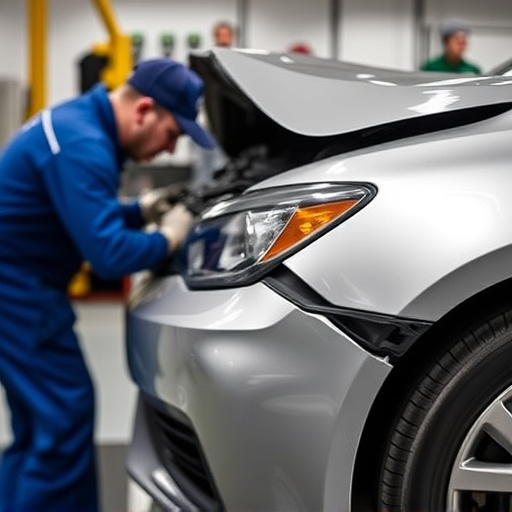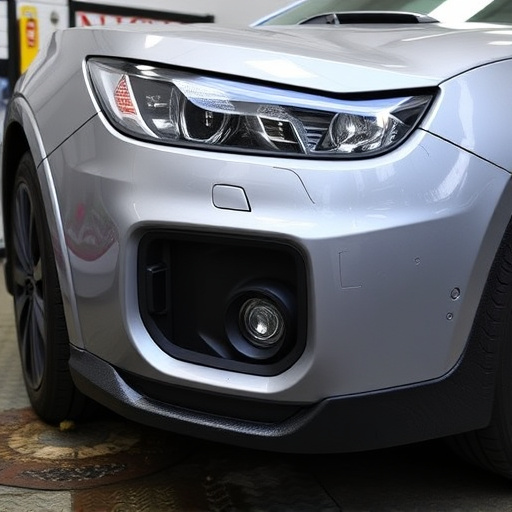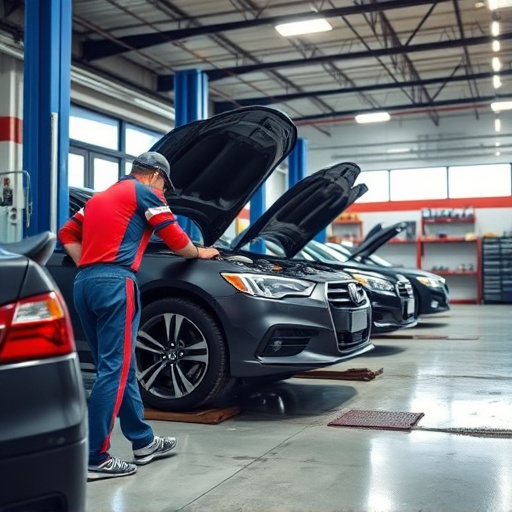Revolutionizing Quality Control: 3D Car Scanning Technology

3D car scanning technology has revolutionized vehicle inspection and repair in automotive facilities…….
Welcome to an in-depth exploration of a groundbreaking technology that is reshaping the automotive industry: 3D Car Scanning. This article aims to provide an extensive guide, delving into every facet of this revolutionary process, from its technical foundations to its global impact and future potential. By the end, readers will grasp the significance of 3D car scanning in enhancing vehicle design, safety, and production efficiency.
3D car scanning technology involves the use of advanced imaging and data capture techniques to create detailed digital representations of vehicles. This process generates precise three-dimensional models, offering an innovative way to visualize, analyze, and manipulate automotive designs. At its core, it combines computer vision, laser scanning, photogrammetry, and other sophisticated methods to digitize physical cars with remarkable accuracy.
The historical context of 3D car scanning traces back to the early 2000s when researchers began exploring 3D modeling and imaging for industrial applications. Over time, advancements in hardware and software have made this technology more accessible and versatile. Today, it is an integral part of various industries, including automotive manufacturing, design, and even entertainment.
Significance: 3D car scanning offers numerous advantages:
Design and Prototyping: Designers can create detailed digital prototypes, enabling virtual testing and visualization before physical production.
Quality Control: It allows for non-destructive testing, identifying defects or inconsistencies in vehicle manufacturing.
Safety and Security: Precise 3D models aid in crash testing, security system design, and enhancing driver assistance technologies.
The impact of 3D car scanning technology is felt worldwide, with key trends shaping its evolution:
Regional Adoption: North America and Western Europe have been early adopters, leading in the implementation of advanced driver assistance systems (ADAS) that rely on 3D scanning. Asia-Pacific regions, particularly Japan and South Korea, are rapidly following suit, focusing on autonomous vehicle development.
Automotive Industry Growth: The global automotive market’s shift towards electric vehicles (EVs) and autonomous driving has fueled the demand for 3D car scanning. These technologies enable more efficient and precise manufacturing processes, essential for high-tech vehicle systems.
Research and Development: Academic institutions and research organizations worldwide are investing in 3D scanning R&D, leading to breakthroughs in sensor technology, data processing algorithms, and model accuracy.
The economic implications of 3D car scanning are profound, impacting various sectors:
| Sector | Impact |
|---|---|
| Automotive Manufacturing | Streamlines production processes, reduces costs through efficient design and quality control, and enables faster time-to-market for new models. |
| Research & Development | Attracts significant investment from automakers and tech companies, fostering innovation in ADAS, autonomous driving, and electric vehicle technologies. |
| Entertainment (Film & Gaming) | Provides realistic 3D models for visual effects, virtual production, and game development, enhancing immersion and realism. |
Global market reports indicate a substantial growth rate for 3D car scanning services and software. Major players in this space include automotive giants like Volkswagen and Tesla, along with tech companies such as Autodesk and 3D Systems.
The field of 3D car scanning has witnessed remarkable technological strides:
LiDAR (Light Detection and Ranging) Scanners: These advanced sensors use laser pulses to create highly accurate 3D maps, ideal for autonomous driving applications. LiDAR scanners offer excellent depth perception and are crucial for perceiving the surrounding environment in self-driving cars.
Structured Light Scanners: Similar to how cameras capture images, structured light scanners project patterns onto objects, capturing detailed surface information. This technology is widely used for creating 3D models of complex shapes.
Deep Learning and AI: Artificial intelligence algorithms enhance data processing, enabling faster and more accurate model generation. Machine learning models can identify specific vehicle components, improving the efficiency of quality control processes.
The development and deployment of 3D car scanning technology are guided by various policies and regulations:
Data Privacy Laws: As 3D scanning involves capturing detailed vehicle data, laws like GDPR in Europe and CCPA in California ensure the secure handling and protection of this information.
Automotive Safety Standards: Organizations like SAE International establish guidelines for ADAS and autonomous driving, incorporating 3D scanning data validation to ensure safety and reliability.
Intellectual Property Rights: Patents and copyright laws protect innovations in 3D scanning technology, encouraging further research while ensuring fair competition.
Despite its numerous advantages, 3D car scanning faces several challenges:
Cost: Initial investment in hardware and software can be high, making it a significant barrier for smaller companies and organizations. However, decreasing costs and shared resources are addressing this issue.
Data Accuracy and Consistency: Ensuring precise and reliable data across different scanning systems and environments remains a challenge. Standardization and calibration procedures are essential to mitigate this.
Ethical Concerns: As 3D scanning captures detailed vehicle information, privacy and data security become critical issues. Companies must implement robust measures to protect sensitive data.
Solutions: To overcome these challenges:
Industry collaborations can drive the development of open standards for data exchange and interoperability.
Continuous research into more affordable and accessible scanning technologies is essential.
Enhancing data validation and quality control processes will improve overall accuracy.
Tesla has leveraged 3D car scanning extensively to develop its Autopilot system. By scanning millions of vehicles, Tesla creates highly detailed 3D maps of road networks. This enables the company to train AI models for advanced driver assistance, including traffic-aware cruise control and lane keeping. The result is a robust autonomous driving feature that continuously improves through real-world data collection.
BMW utilizes 3D car scanning as a cornerstone of its design and development process. They create digital twins of physical prototypes, enabling virtual testing for crash safety, aerodynamics, and ergonomics. This approach reduces the need for costly physical tests, accelerates design iterations, and ensures a superior final product.
Ford Motor Company has implemented augmented reality (AR) guided by 3D scanning data to enhance manufacturing precision. Workers use mobile devices with AR applications to overlay digital instructions on physical vehicles during assembly. This technology improves efficiency, reduces errors, and allows for real-time quality control checks.
The future of 3D car scanning technology is promising, with several growth areas and emerging trends:
Autonomous Vehicles: As autonomous driving becomes more widespread, 3D scanning will play an increasingly critical role in mapping and perceiving urban environments. LiDAR and RGB-D sensors will be essential for creating high-resolution digital twins of cities.
Digital Twin Technology: The concept of digital twins—virtual replicas of physical entities—will gain traction across industries. In automotive, this technology will enable predictive maintenance, performance optimization, and personalized vehicle customization.
Advanced Material Testing: 3D scanning can be coupled with material testing to analyze structural integrity and performance under various conditions. This will lead to the development of lighter, stronger materials for vehicles.
Global Standardization: Efforts to standardize data formats and communication protocols between different scanning systems will improve interoperability, making it easier to integrate 3D car scanning into various workflows.
In conclusion, 3D car scanning technology is a powerful enabler of automotive innovation, safety, and efficiency. Its global impact spans multiple sectors, from manufacturing and design to research and autonomous driving. As the technology continues to evolve, it will play an increasingly vital role in shaping the future of transportation. By overcoming challenges and embracing emerging trends, 3D car scanning promises to drive significant advancements in the automotive industry and beyond.
Q: How does 3D car scanning improve vehicle design?
A: 3D scanning allows designers to create detailed digital prototypes, enabling virtual testing and visualization. This process accelerates design iterations, improves accuracy, and reduces the need for costly physical models.
Q: Can 3D car scanning replace traditional testing methods?
A: While 3D scanning is a powerful tool, it typically complements traditional testing rather than replacing it entirely. Physical testing remains crucial for certain safety and performance assessments. However, it can significantly reduce costs and time in the development process.
Q: What are the main types of 3D car scanners?
A: The primary types include LiDAR scanners (for high-resolution mapping), structured light scanners (for detailed surface capture), and photogrammetry systems (using multiple cameras for 3D reconstruction). Each has unique strengths, depending on the application.
Q: How does 3D scanning contribute to autonomous vehicles?
A: 3D scanning is vital for autonomous driving as it enables accurate mapping of the surroundings, pedestrian detection, and obstacle avoidance. LiDAR scanners, in particular, are used to create high-definition 3D maps, crucial for safe and efficient self-driving operations.

3D car scanning technology has revolutionized vehicle inspection and repair in automotive facilities…….

3D car scanning technology has revolutionized auto repairs, enhancing accuracy and efficiency in veh…….

3D car scanning technology transforms automotive repairs and restorations by delivering unprecedente…….

3D car scanning technology transforms automotive diagnostics by creating precise digital models of v…….

3D car scanning technology revolutionizes automotive repairs, offering unprecedented precision and e…….

3D car scanning technology revolutionizes the automotive industry by creating accurate digital model…….

3D car scanning technology revolutionizes collision repair by accurately capturing vehicle details,…….

3D car scanning technology revolutionizes automotive repairs by delivering precise 3D models of vehi…….

3D car scanning technology revolutionizes collision assessment and repair by creating precise digita…….

The automotive industry is transforming with the adoption of 3D car scanning technology, enhancing p…….